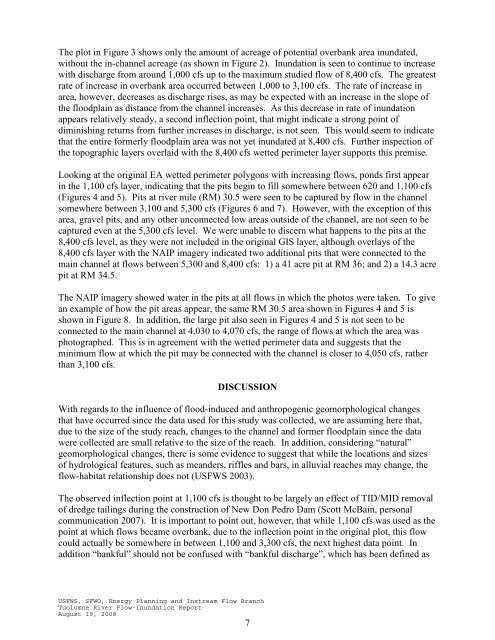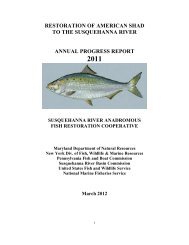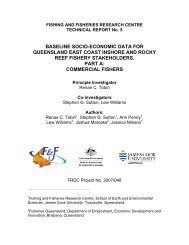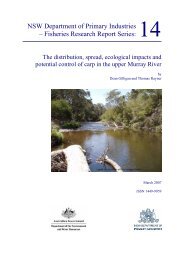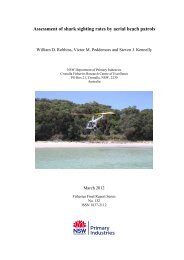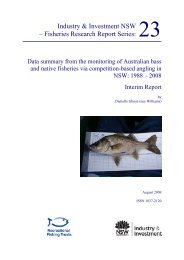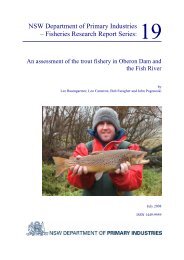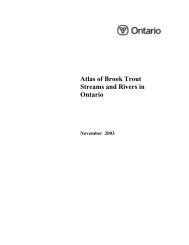Tuolumne River Flow-Inundation Report - U.S. Fish and Wildlife ...
Tuolumne River Flow-Inundation Report - U.S. Fish and Wildlife ...
Tuolumne River Flow-Inundation Report - U.S. Fish and Wildlife ...
You also want an ePaper? Increase the reach of your titles
YUMPU automatically turns print PDFs into web optimized ePapers that Google loves.
The plot in Figure 3 shows only the amount of acreage of potential overbank area inundated,<br />
without the in-channel acreage (as shown in Figure 2). <strong>Inundation</strong> is seen to continue to increase<br />
with discharge from around 1,000 cfs up to the maximum studied flow of 8,400 cfs. The greatest<br />
rate of increase in overbank area occurred between 1,000 to 3,100 cfs. The rate of increase in<br />
area, however, decreases as discharge rises, as may be expected with an increase in the slope of<br />
the floodplain as distance from the channel increases. As this decrease in rate of inundation<br />
appears relatively steady, a second inflection point, that might indicate a strong point of<br />
diminishing returns from further increases in discharge, is not seen. This would seem to indicate<br />
that the entire formerly floodplain area was not yet inundated at 8,400 cfs. Further inspection of<br />
the topographic layers overlaid with the 8,400 cfs wetted perimeter layer supports this premise.<br />
Looking at the original EA wetted perimeter polygons with increasing flows, ponds first appear<br />
in the 1,100 cfs layer, indicating that the pits begin to fill somewhere between 620 <strong>and</strong> 1,100 cfs<br />
(Figures 4 <strong>and</strong> 5). Pits at river mile (RM) 30.5 were seen to be captured by flow in the channel<br />
somewhere between 3,100 <strong>and</strong> 5,300 cfs (Figures 6 <strong>and</strong> 7). However, with the exception of this<br />
area, gravel pits, <strong>and</strong> any other unconnected low areas outside of the channel, are not seen to be<br />
captured even at the 5,300 cfs level. We were unable to discern what happens to the pits at the<br />
8,400 cfs level, as they were not included in the original GIS layer, although overlays of the<br />
8,400 cfs layer with the NAIP imagery indicated two additional pits that were connected to the<br />
main channel at flows between 5,300 <strong>and</strong> 8,400 cfs: 1) a 41 acre pit at RM 36; <strong>and</strong> 2) a 14.3 acre<br />
pit at RM 34.5.<br />
The NAIP imagery showed water in the pits at all flows in which the photos were taken. To give<br />
an example of how the pit areas appear, the same RM 30.5 area shown in Figures 4 <strong>and</strong> 5 is<br />
shown in Figure 8. In addition, the large pit also seen in Figures 4 <strong>and</strong> 5 is not seen to be<br />
connected to the main channel at 4,030 to 4,070 cfs, the range of flows at which the area was<br />
photographed. This is in agreement with the wetted perimeter data <strong>and</strong> suggests that the<br />
minimum flow at which the pit may be connected with the channel is closer to 4,050 cfs, rather<br />
than 3,100 cfs.<br />
DISCUSSION<br />
With regards to the influence of flood-induced <strong>and</strong> anthropogenic geomorphological changes<br />
that have occurred since the data used for this study was collected, we are assuming here that,<br />
due to the size of the study reach, changes to the channel <strong>and</strong> former floodplain since the data<br />
were collected are small relative to the size of the reach. In addition, considering “natural”<br />
geomorphological changes, there is some evidence to suggest that while the locations <strong>and</strong> sizes<br />
of hydrological features, such as me<strong>and</strong>ers, riffles <strong>and</strong> bars, in alluvial reaches may change, the<br />
flow-habitat relationship does not (USFWS 2003).<br />
The observed inflection point at 1,100 cfs is thought to be largely an effect of TID/MID removal<br />
of dredge tailings during the construction of New Don Pedro Dam (Scott McBain, personal<br />
communication 2007). It is important to point out, however, that while 1,100 cfs was used as the<br />
point at which flows became overbank, due to the inflection point in the original plot, this flow<br />
could actually be somewhere in between 1,100 <strong>and</strong> 3,300 cfs, the next highest data point. In<br />
addition “bankful” should not be confused with “bankful discharge”, which has been defined as<br />
USFWS, SFWO, Energy Planning <strong>and</strong> Instream <strong>Flow</strong> Branch<br />
<strong>Tuolumne</strong> <strong>River</strong> <strong>Flow</strong>-<strong>Inundation</strong> <strong>Report</strong><br />
August 19, 2008<br />
7


